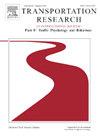The effectiveness of driver monitoring systems in mitigating visual distraction depends on secondary task complexity and experience − A driving simulator study
IF 3.5
2区 工程技术
Q1 PSYCHOLOGY, APPLIED
Transportation Research Part F-Traffic Psychology and Behaviour
Pub Date : 2025-02-01
DOI:10.1016/j.trf.2024.12.008
引用次数: 0
Abstract
Touchscreens that offer various functions to the driver have become an integral part of the user interface in vehicles. To enable the use of these functions while preventing driver distraction, there is a trend towards implementing driver monitoring systems (DMS). DMS detect distraction and warn drivers accordingly. However, there is limited empirical evidence on the effectiveness of DMS in preventing visual distraction. Furthermore, potential interactions with contextual factors like secondary task complexity and task experience are neglected so far. Therefore, the present study investigated the effectiveness of a DMS, based on the Euro NCAP protocol, that issued warnings when long distraction (≥3 s) or visual attention time sharing (≥10 s in a 30 s window) occurred while driving on a highway. Glance behavior of 57 participants was analyzed while performing secondary tasks on an in-vehicle display with varying levels of task complexity and task experience. The effectiveness of the DMS depended on the task complexity and task experience. For more complex tasks, the DMS significantly reduced the number and total duration of glances to the display, but only for inexperienced trials. For experienced trials, no effect of the DMS was found. For less complex tasks, the DMS significantly reduced the duration of single glances and the proportion of long glances at the display, regardless of task experience. The results indicate that the effectiveness of DMS in reducing distraction is not as straightforward as assumed, emphasizing the importance of evaluating DMS in the context of contextual factors to draw accurate conclusions.
求助全文
约1分钟内获得全文
求助全文
来源期刊
CiteScore
7.60
自引率
14.60%
发文量
239
审稿时长
71 days
期刊介绍:
Transportation Research Part F: Traffic Psychology and Behaviour focuses on the behavioural and psychological aspects of traffic and transport. The aim of the journal is to enhance theory development, improve the quality of empirical studies and to stimulate the application of research findings in practice. TRF provides a focus and a means of communication for the considerable amount of research activities that are now being carried out in this field. The journal provides a forum for transportation researchers, psychologists, ergonomists, engineers and policy-makers with an interest in traffic and transport psychology.

 求助内容:
求助内容: 应助结果提醒方式:
应助结果提醒方式:


